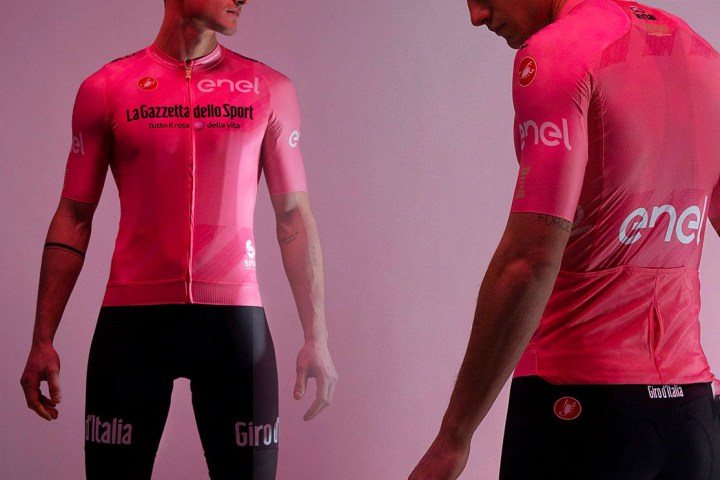Outside of high school science class, there are only a few people who think about Sir Isaac Newton’s laws of motion on a daily basis. There are the academics, obviously — scientists and engineers — as well as people who make planes, trains, and automobiles. But there are also those who design aerodynamic apparel for athletes.
If you’ve forgotten the basic principle of Newton’s second law, here’s a refresher. It states the rate of change in the momentum of an object is equal to the product of its mass and velocity.
This is an equation Steve Smith, brand manager of Italian sports clothier Castelli, thinks of often.

He knows the cycling teams sporting Castelli suits are some of the fastest in the world, but how can the fabric, the folds, and the fit of their kit get them one, or two, more seconds of lead time ahead of the competition? The answer lies in the quest to eliminate aerodynamic drag.
“When a cyclist is riding through air, 90% of their power, depending on their speed, is going toward pushing out the air,” Smith said. “The aerodynamics of the cyclist is the biggest factor on their speed.”
The faster a cyclist goes, no matter their mass or velocity, the harder the air blows against them. Yet, optimizing the aerodynamics of clothing may seem like a lot of effort for minimal gain.
But it’s within those milliseconds where world records are shattered and gold medals are won.
And it’s just more enjoyable.

“Aerodynamic clothing done right doesn’t have to come at the cost of comfort — sometimes it’s nice to put something floppy on — but it’s an easy gain to go a little bit faster,” Smith said. “And cycling is more fun when you go a little bit faster.”
There’s a lot at stake when a rider slaps a jersey on their back or zips up a suit. Because of that, the companies that develop aerodynamic clothing have increasingly relied on technology to improve the process. Whether it’s with biomechanical equipment, performance modeling using data from wind tunnel sessions, 3D imaging, or “smart” textiles — the littlest advances are welcome.
The production of aerodynamic clothing is perhaps as competitive as the sports it’s developed for. The folks at the helm of these technological apparel developments keep tight-lipped and the process top secret. They know the placement of a zipper can have an impact on the time their racers cross the finish line. And that’s not information they give out freely.
The science behind the suit

Jon Paton has a Ph.D. in engineering, which not many owners of clothing brands can say. He runs Vorteq, a three-year-old research and development company based in England that develops one-of-a-kind, customized sports equipment for cyclists based on 3D modeling of their “exact geometric proportions.”
“It’s a matter of being data-driven, making things bespoke for that athlete,” he said. “What tension do those fabrics need to be? Where do I choose to put a seam?”
Vorteq also puts its money where its mouth is, according to Paton. Any rider interested in what the company has to offer is invited to come to its headquarters and be fitted for a customized suit. If the suit Vorteq produces is not as fast as the suit they originally came in with, they get their money back, guaranteed.

The first step in creating a Vorteq cycling suit is taking a 3D scan, using Artec Leo equipment, of the athlete on the bike, in position. Using the 3D model, not measurements, fabrics are draped over a 3D computation environment of the athlete to ensure there are no wrinkles or loose sections.
After fabric choices are made, the athlete heads back to the wind tunnel for testing to replicate the twists, turns, and conditions of a race in the new suit. There, data is collected to determine the aerodynamic drag, and if it shows the Vorteq suit does indeed improve the athlete’s performance, the design goes home with them.
Can tech-enhanced suits close the gap?

Paton said he has spent thousands of hours in the wind tunnel at the Silverstone Sports Engineering Hub to determine what fabrics should be placed where (no single suit contains just one fabric) and has found that one size does not fit all.
“If you buy an off-the-shelf suit and it has a wrinkle on the shoulder, that could be worth 1% or 2% of drag,” Paton told Digital Trends. “If you ask an athlete to go and find 2% more power, it might take them years, or it might be impossible.”
Castelli, Smith said, works in a similar way, too. The company uses CFD (computational fluid dynamics) modeling to see how the body moves through changing environments (sun, rain, wind, or snow) and what materials (like nylon and polyester) work best where.
Year over year, Castelli has gathered mountains of data on what fabrics work best where, and for what speed. Rigid paneling on the shoulder may be great for a cyclist traveling at 40 miles per hour, but not optimal for another going 20. It’s all about A/B testing, and working with the leading aerodynamicists. But even then, there’s still so much to learn.
“There’s no book about this, so we have to come up with our own scientific research,” Smith said. “A leg pedaling at 90 RPMS is completely different from what an engineer has to do to make an airplane or a car, which is a static form moving through the wind.”
Speed for all

Cyclists depend on their skinsuits just as much as they depend on their legs to propel them through time trials, hill climbs, and road races. Unlike other sporting events, the fastest riders in cycling competitions are often placed in the back of the pack and have to fight their way to the front by pushing harder and faster. If a seam snaps and a 1-centimeter piece of fabric is flapping in the wind, that could push a first-place rider to second. It’s that minute.
But speed isn’t just important for professional racers. The high tech gear, 3D modeling and data analysis used to determine the best fit for Olympians sporting state-of-the-art suits can also be found in the threads of the gear hanging in your local sporting goods store. And brand managers like Smith prefer it that way.
“The stuff that’s happening for all the lead athletes really does trickle down and make your cycling experience more fun, more comfortable, and faster,” he said. “It’s the cheapest speed you can buy on your bike.”



